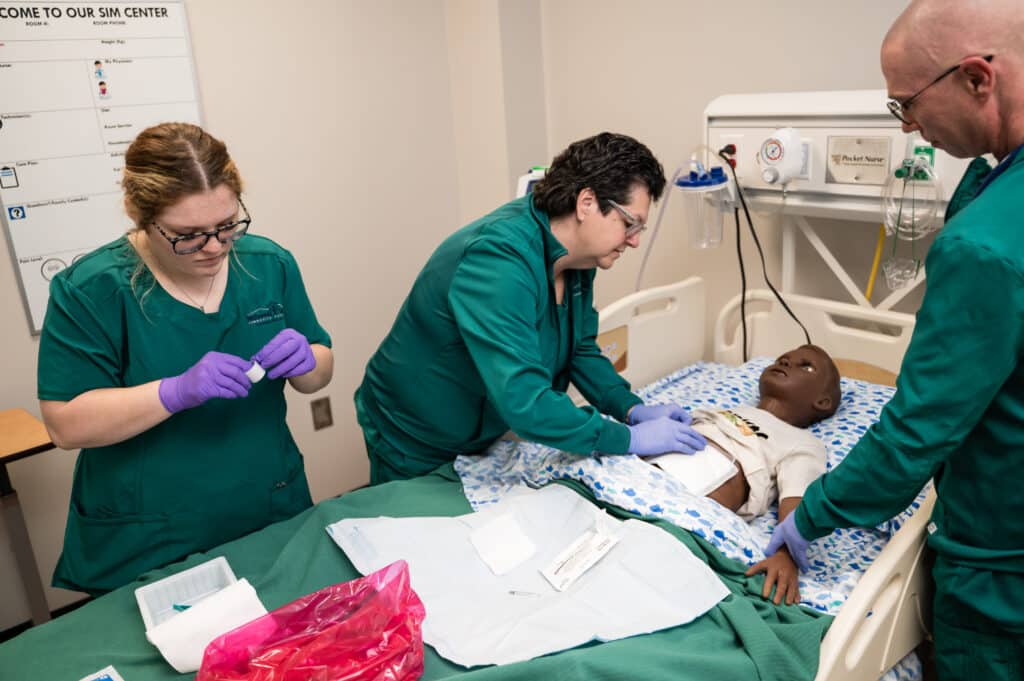On September 16, 2024, a group of five Achieving the Dream coaches who work with rural community colleges in ATD’s Network participated in a roundtable focused on rural community colleges and how they can best serve their communities. The coaches’ discussion touched on the unique role of rural community colleges in promoting social mobility and economic development, successful strategies implemented at rural Network institutions, key initiatives in which some of these colleges have participated, and advice applicable to rural colleges nationwide.
Meet the roundtable participants:
Dr. Constance (Connie) Green: leadership coach; former president, Tillamook Bay Community College (Oregon)
Dr. Gregory (Greg) Hodges: leadership coach; president, Patrick & Henry Community College (Virginia)
Dr. Roderick (Rod) Brown: leadership coach; former vice president for academic affairs, Ivy Tech Community College (Indiana)
Dr. Paula Pitcher: data, holistic student supports coach; interim director of holistic student supports, Achieving the Dream
James (Dub) Green: data coach; former associate vice president for planning and accreditation, Trident Technical College (South Carolina).
Read the discussion:
Below is the transcript from their recorded conversation. It has been edited for clarity and concision.
Ryan Knight: Good morning! Thank you all for joining this rural roundtable. I’m really excited for this conversation about rural colleges and the work that Achieving the Dream is doing to support them.
To get us started, our first question is: What sets rural community colleges apart? What’s unique about them compared to their urban and suburban counterparts, particularly how they create opportunities for social mobility and economic opportunity?
Dub Green: When working with rural colleges, there’s a real family atmosphere. Many have second-generation employees. Some even attended the day care center at the college when they were children. There’s a great urgency to work with their area businesses and make sure they remain viable.
Rod Brown: Sometimes rural community colleges need to be even more nimble than others. They attend to the various desires of the students they serve. Some students seek opportunities that allow them and their families to remain and thrive in their communities, but others want to move out and explore opportunities elsewhere. So, the dual mission of community colleges becomes even more complex for rural institutions.
Greg Hodges: I think rural schools have an outsized influence on the economic development of the community. For many, they are the only higher ed provider. They aren’t just at the table for economic development and mobility—they are the table. They’re the means by which students access economic mobility.
Connie Green: I’ve been president of a rural college and an interim for two rural colleges. My calendar was full, mainly from outside appointments — economic development boards, hospital boards, K-12 advisory committees. You end up being linked to a major employer. You are there because it’s your title. You provide access to how [students] get workforce training and education. …You are at every table. Your table is their table.

McDowell Tech’s practical nursing students fine tune their clinical skills in the college’s simulation lab.

Students in McDowell Tech’s mechatronics lab troubleshoot problems with a malfunctioning robot. The college has ramped up its workforce training due to regional demand and population growth.
Ryan Knight: Thank you all so much. I’m excited to hear about a couple of specific community colleges. Rod, Dub, could you both tell me a little bit about a rural college you’re working with? What are they doing that you find especially compelling and exciting?
Dub Green: McDowell Technical Community College in North Carolina has increased workforce training tremendously due to regional demand and population growth. Even with limited resources, they’ve blended the coursework, including both continuing education and workforce training with credit students in the same classroom. This lets them take advantage of one instructor.
They’ve also created several short — three- to nine-month — workforce certificates that get people right into the workforce quickly. Students can reenter the program later for more advanced training without losing momentum and advance their skills to earn another credential if they wish.
Rod Brown: I want to build on a lot of what was said in the in the first question about family atmosphere. At Northwood Technical College in Wisconsin, students feel a sense of family from the faculty and staff from the moment they arrive. They’re known by their name, their major, their goals, their struggles, and their dreams. That level of intimacy has informed their new strategic plan and mission statement that have helped to unify the four campuses.
Ryan Knight: Rod, Dub, thank you both. Connie, you’ve been coaching as part of North Carolina Rural College Leaders Program, a capacity-building initiative of the Belk Center and Achieving the Dream. Can you share a little bit about that program and a key insight that emerged?
Connie Green: The North Carolina Rural College Leaders Program ran over two and a half years and involved 10 rural community colleges with newer presidents. The focus was on developing leaders to support students and communities.
Greg has said several times that when you meet one rural college, you meet one rural college. And that is true. When you’ve got 10 colleges, all in North Carolina, you have to remember they’re not the same. There are 10 different colleges with differing levels of capacity and different gaps. They all approach things differently.
At the end, all 10 colleges shared their action plans. What stood out was the free-flowing discussion among them. No one had all the answers, but the learning community developed on its own. These colleges were determined to grow, avoiding a deficit mentality and, instead, focusing on their strengths.

A Clovis Community College student works on a graphic using the Adobe Creative Cloud programs for Viva! (the CCC Hispanic student organization). The college has ensured that the digital skills sought by employers are embedded in course curricula.

A Northwood Technical College student receives personal attention from a faculty member. The family atmosphere helped inform the college’s new strategic plan and mission statement that have helped to unify its four campuses.
Ryan Knight: Wonderful. Thank you, Connie. Paula, Greg, both of you have served as coaches for colleges that are part of the Building Resiliency in Rural Communities for the Future of Work cohort. Some reading this roundtable have already seen ATD’s recent report on digital skills developed through that initiative. But I’d like to ask each of you to tell us about this initiative and the work you supported by coaching. What’s a key insight you’ve gained about the conditions that need to be in place to achieve success in rural areas?
Greg Hodges: The Rural Resiliency initiative was very focused on digital literacy skills. One school even developed a spiraling approach to integrating digital skills into the curriculum. I think that’s a really good lesson for any school, rural or urban: How are we preparing all students to be part of the new digital economy?
Paula Pitcher: When Greg and I started working with Clovis Community College (New Mexico), they had a strong data structure. We introduced the early momentum metrics, which was really big for them, especially identifying students who accumulated zero credits in their first semester. They also started to see how digital skills were embedded in all of the courses they offered. With a digital literacy skills inventory list, they identified what digital skills employers needed so they could ensure those skills were embedded in the pathways.
Ryan Knight: To close, what is one tip or recommendation you’ve offered to a rural college that you think would also pertain to all rural colleges, both in and out of ATD’s Network, nearly 40% of which is composed of rural institutions.
Dub Green: Measure everything to gauge impact. Rural colleges often have no measurable metrics for programs like student success coaching. Make sure programs have a positive effect, and, if not, adjust.
Connie Green: I would add to that: measuring economic and community vibrancy. The reason you’re at the table as a rural community college is your role in creating thriving communities, no matter what the size. Be it a student, a community member, a college faculty or staff member, you are really all in this together.
Rod Brown: Reviewing disaggregated data across multiple factors is crucial, particularly for rural colleges. By intentionally capturing the student voice, as well as the voices of faculty and student-facing staff, you get that mix of the quantitative and the qualitative. I think rural institutions can identify support strategies both inside and outside the classroom that can promote those equitable outcomes that they’re seeking to achieve.
Paula Pitcher: Often times, rural community colleges are so small and have such limited resources that they are unable to provide everything that a student may need. My recommendation would be to explore partnerships and how they can help with student challenges. Take transportation, for example. Rural colleges do a great job serving their students but can be miles away and isolated. Mental health support and child care are examples of community partnerships that could benefit students.
Greg Hodges: In many rural communities, the demography is changing pretty rapidly. These colleges have a real opportunity to not only train the workforce but also to help the community understand the new reality of their upcoming demography.
Many of these schools are already partnering with their K–12 counterparts. But if you go all the way down into the preschool and the elementary level, that’s where you see what the demography is going to look like in another generation. So, preparing the communities to be where they need to be from workforce development in fifteen and twenty years is as much a part of that community college’s mission as training tomorrow’s workforce. That really outsized influence that community colleges have helps keep regional economic development at the forefront.
Ryan Knight: Thank you all. This roundtable has been an absolute pleasure.
Read in-depth about ATD’s work with Isothermal Community College, one of seven colleges in the Accelerating Equitable Outcomes (AEO) cohort of rural-serving institutions.
